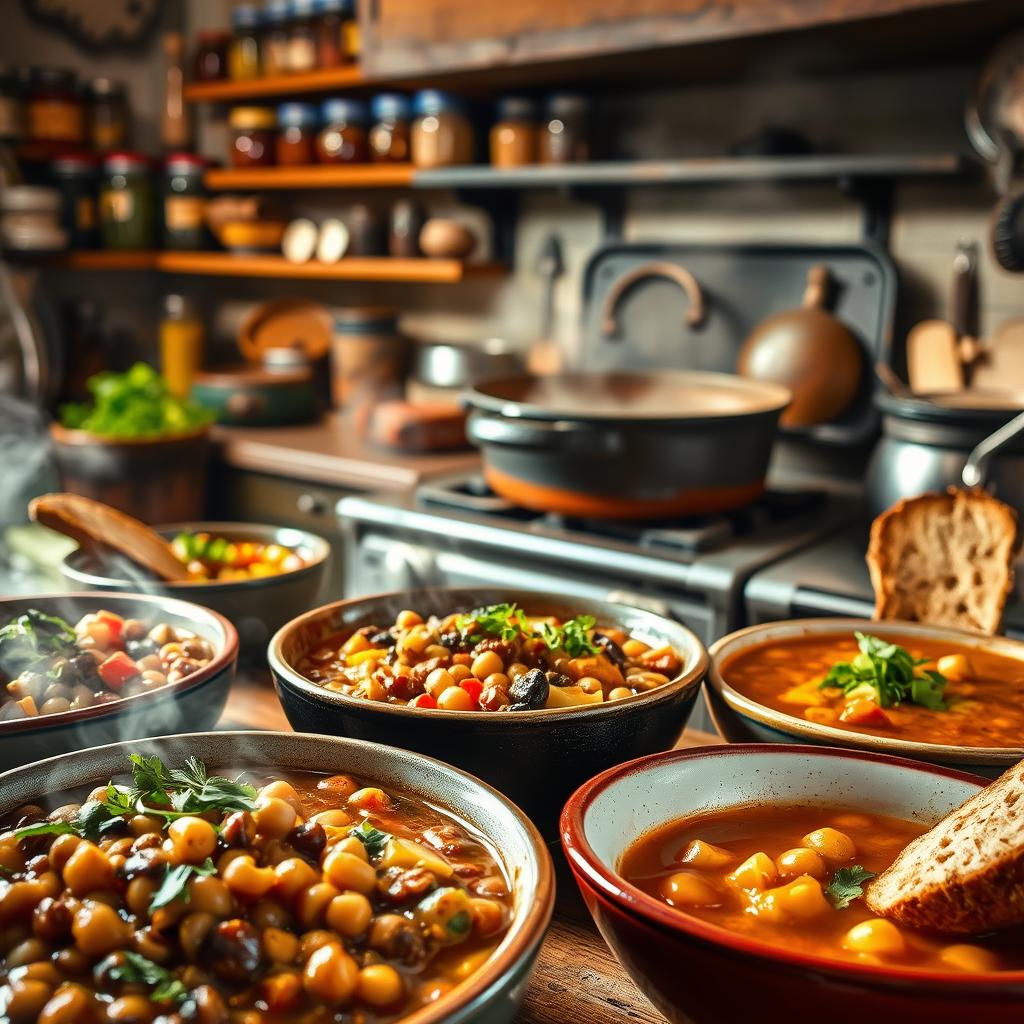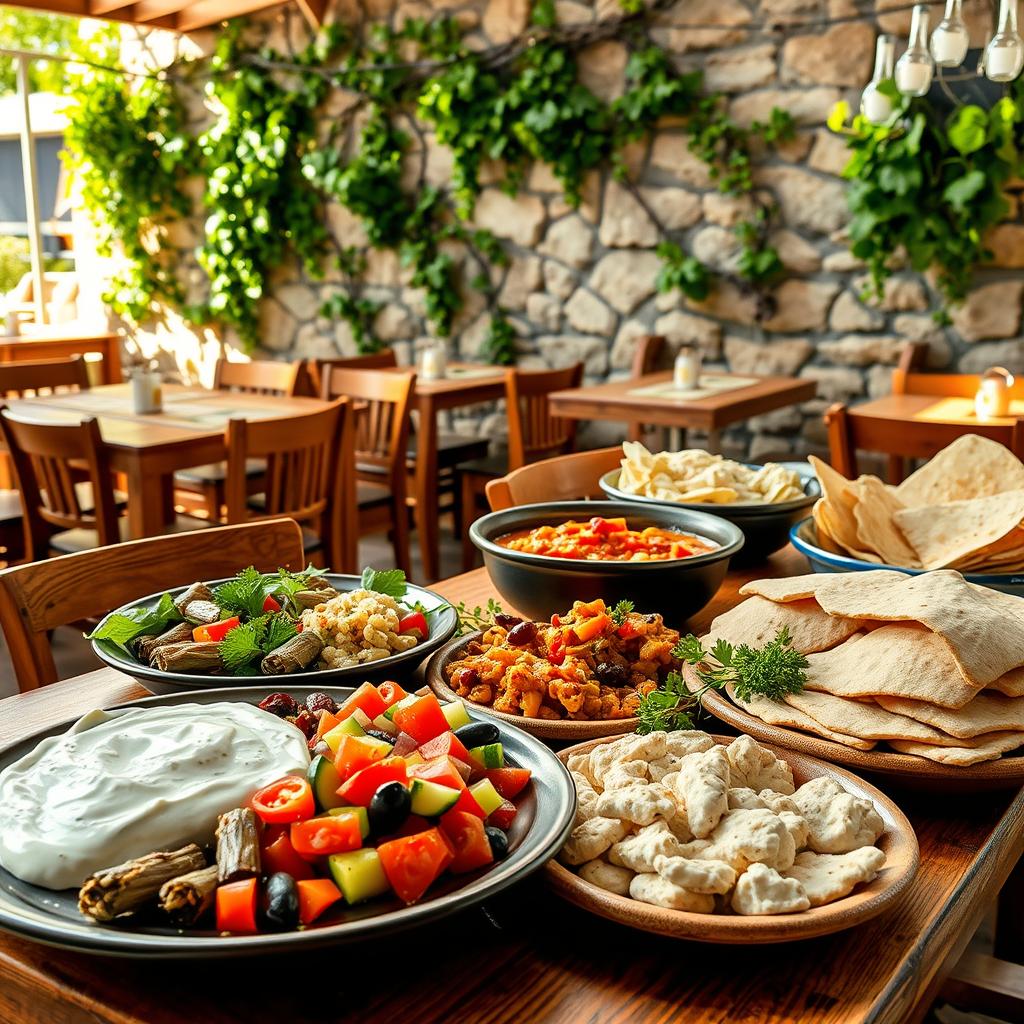vegan greek recipes open a simple way to enjoy classic Mediterranean flavor using plant-based ingredients. Do you ever wonder how traditional dishes like dolmades or revithosoupa can keep their soul without dairy or meat? This guide shows you the path.
You will find clear tips on ingredients, timing, and swaps that keep texture and taste true to form. Learn pantry basics and quick techniques for breads, dips, and hearty mains so you can cook at home or order with confidence when dining out in the United States.
For step-by-step recipes and authentic technique, check trusted sources like The Greek Vegan, oil-free adaptations at Forks Over Knives, and practical travel tips at VeggiesAbroad. Expect practical advice that helps every dish sing without animal products.
Key Takeaways
- You can recreate authentic greek food using accessible ingredients and smart swaps.
- Focus on herbs, olive oil, and texture to preserve classic flavor in each dish.
- Use pantry staples for quick weeknight meals and longer builds for festive feasts.
- Trusted sites offer step-by-step recipes and tips for oil-free or traditional methods.
- When dining out, ask for dishes cooked in olive oil and omit dairy for safe choices.
Vegan Greek Recipes to Master Authentic Mediterranean Flavors
Start by choosing traditional dishes that lean on tomatoes, olive oil, and simple herbs to deliver real taste.
Begin with familiar dishes like dolmades, gemista, briam, and fasolada. These rely on pantry ingredients and slow cooking for deep flavor. You’ll love how basic elements become satisfying with a little time.
Pick one dish per category — a soup, a salad, a bake — to learn timing and layering. For stuffed vegetables, add pine nuts and bright herbs for texture and aroma.
- Many dishes are naturally dairy-free; feel free to omit cheese and boost herbs and lemon instead.
- Use olive oil thoughtfully: drizzle for finish or roast with less oil and more acid from tomatoes and lemon.
- Quick wins: a no-feta Greek salad, politiki salad with red wine vinegar, or a tomato-based bean bake.
When dining out or planning meals, consult trusted guides like VeggiesAbroad for ordering tips and swaps so you can enjoy authentic food at home or on the road.
Classic taverna staples you’ll love
From oven-baked beans to stuffed vegetables, these staples are built on texture and bright herbs.
Gigantes plaki
Gigantes plaki is a beloved taverna dish made from large white beans baked in a rich tomato sauce with onions, garlic, and herbs. It offers deep, rustic comfort and reheats well for weeknight dinners.
Gemista
Gemista are stuffed tomatoes and peppers filled with rice, herbs, and sometimes pine nuts for light crunch. A pinch of cinnamon in the filling adds gentle warmth; use it sparingly to complement, not dominate.
Dolmades
Dolmades showcase grape leaves wrapped around herbed rice. Many tavernas serve this dish made vegan by default; it pairs beautifully with olives and warm bread. See background and technique at The Greek Vegan.
Briam / tourlou
Briam is a tray of roasted vegetables dressed with olive oil and herbs until caramelized. Serve family-style with pita and a simple herb-forward sauce for a full spread.
“Layer acidity from tomatoes, aromatics from herbs, and a light drizzle of olive to finish.”
| Dish | Main components | Serve with |
|---|---|---|
| Gigantes plaki | White beans, tomato sauce, herbs | Bread, olives |
| Gemista | Tomatoes, peppers, rice, pine nuts | Pita, herb sauce |
| Dolmades | Grape leaves, herbed rice | Olive, lemon wedges |
Hearty soups and stews for cozy nights

Simple, slow-simmered pots make weeknight dinners feel like a treat. They rely on pantry staples and gentle heat to build deep flavor without fuss.
Fasolada is the national white bean staple. Large white beans simmer with tomatoes, onions, carrots, and celery in water until soft and savory. Finish with a splash of red wine or a drizzle of oil to deepen the broth.
Revithosoupa is a creamy chickpea soup that cooks in one pot. Use carrots, celery, sage, and thyme for warmth and aroma. The Greek Vegan’s version is a reliable guide: https://www.thegreekvegan.com/revithosoupa/.
Fakes uses red lentils or brown lentils for an earthy, quick-cooking dish. Tomatoes and herbs form the base, and you brighten the bowl at the end with a splash of red wine vinegar.
- Season with salt near the end so beans stay tender and fully flavored.
- Add a small splash of red wine early, then simmer off alcohol for complexity.
- Adjust with extra water if tomatoes thicken the pot as it rests.
- Garnish with fresh herbs and lemon just before serving.
“These soups are perfect for meal prep—flavors deepen overnight and they reheat beautifully.”
| Soup | Key ingredients | Finish | Serve with |
|---|---|---|---|
| Fasolada | White bean, tomatoes, carrot, celery | Red wine or olive oil, salt | Warm bread, olives |
| Revithosoupa | Chickpeas, carrots, sage, thyme | Lemon squeeze, fresh herbs | Pita or roasted veg |
| Fakes | Lentils, tomatoes, onion, herbs | Red wine vinegar splash | Crisp salad, bread |
Breads, dips, and spreads to pair with every dish
Round out your meal with warm loaves and creamy spreads that lift every plate.
Good bread and bold dips make a simple spread feel complete. Start with a soft round you can roll around fillings, then add a few contrasting purées and a bright sauce.
Greek pita bread and pita bread wraps
Make Greek pita bread for wraps and mezze boards; unlike Middle Eastern pockets, these rounds don’t open into a pocket and are perfect for rolling. The Greek Vegan’s version rises in about 30 minutes and works well for wraps: Greek pita bread.
Eliopsomo (traditional olive bread)
Eliopsomo is a no-knead, slow-rise olive loaf that fills the kitchen with aroma. Use quality olive oil and chopped olives for depth of flavor. Try the authentic method here: Eliopsomo.
Skordalia and Greek fava
Skordalia gives a bold garlic punch balanced by red wine vinegar and silky potatoes. Forks Over Knives offers an oil-free take that swaps in plant milk and almond meal: oil-free options.
Greek fava is a smooth yellow split pea puree finished with olive oil and lemon juice for brightness. Garnish either dip with chopped nuts for crunch.
- Serve: bread, skordalia, fava, olives, and a crisp salad make an easy mezze.
- Timing: bake bread first so it’s warm; prep dips ahead—they improve with a little rest.
- Sauces: try tahini-lemon or cashew tzatziki to cool garlicky dips.
| Item | Main notes | Serve with |
|---|---|---|
| Pita bread | Soft rounds for wraps; 30 min rise | Skordalia, fava, fillings |
| Eliopsomo | No-knead olive loaf; slow-rise aroma | Soup, salads, cheese alternatives |
| Skordalia / Fava | Garlic-potato dip; split pea puree | Bread, roasted veg, chopped nuts |
Fresh salads and veg-forward sides
Bright, herb-forward salads and simple vegetable sides keep a Mediterranean meal feeling fresh and balanced.
Greek salad (horiatiki) is easy to adapt: ripe tomatoes, cucumber, red onion, peppers, and olives tossed with olive oil, lemon, and herbs. Skip the feta and you still get a briny, refreshing bowl you’ll love.
Politiki salad
Politiki centers on shredded cabbage, carrots, and celery dressed with olive oil and red wine vinegar. Its crunch and tang make it a crisp side for heavier mains.
Horta vrasta and spanakorizo
Horta vrasta showcases boiled greens finished with olive oil and lemon for a clean, nourishing plate.
Spanakorizo blends spinach and rice with dill and onion into a comforting vegetable dish. Serve it with warm bread or pita and a wedge of lemon.
- Quick tips: keep knife cuts even so each forkful mixes tomatoes, cucumber, peppers, and olives.
- Season with a pinch of pepper and a final drizzle of wine vinegar to brighten the vegetables.
- For more background and regional notes, see guidance at VeggiesAbroad.
“Combine one salad, one dip, and warm bread for a simple mezze that hits texture and flavor.”
vegan greek recipes reimagined: modern plant-based spins

Rethink familiar mains as layered lentil bakes and handheld gyros that still taste like the originals.
Pastitsio and moussaka translate well when you use a hearty lentil filling spiced with cinnamon and nutmeg. Top these bakes with a creamy dairy-free milk sauce so slices hold together and feel indulgent without dairy.
Build roasted veggie gyros on warm pita with sliced tomatoes, onion, and a cooling cashew-based tzatziki. For lighter plates, try oil-free salad ideas that rely on herbs, brine, and bright acid to deliver punch.
- Use: a light tomato sauce seasoned with garlic and oregano for pasta bakes that echo dishes like the originals.
- Moussaka tip: layer eggplant and potatoes with the lentil filling so the casserole slices cleanly.
- Batch: make extra sauce and dairy-free milk to reuse in bowls and wraps during the week.
- Seasonings: keep oregano, garlic, lemon, and dill consistent to preserve authentic flavor.
“Choose roasting, baking, and blended nut sauces to replace dairy textures while keeping comfort intact.”
| Dish | Main swap | Key technique |
|---|---|---|
| Pastitsio | Lentils for meat; cinnamon, nutmeg | Bake with creamy dairy-free milk sauce |
| Moussaka | Lentil filling; eggplant layers | Sear eggplant, layer, and bake until set |
| Gyro | Roasted veggies; cashew tzatziki | Warm pita, assemble with tomatoes and onions |
For modern, oil-free and dairy-free versions, see Forks Over Knives for tested methods and full recipes.
Your Greek vegan pantry: ingredients, swaps, and time-saving tips
Stocking the right basics saves time and keeps flavor honest in every dish you make.
Keep staples on hand so you can finish a meal in under 30 minutes. Olive oil and wine vinegar form quick dressings. Lemon juice and tomatoes add bright lift to stews and salads.
For proteins, store dried or canned beans and rice. Grape leaves in jars let you roll dolmades fast. Make a simple garlicky tomato sauce and reuse it across bakes and stuffed vegetables.
- Stock extra-virgin olive oil, red wine vinegar, lemon, and tomatoes to build dressings and quick pan sauces the Greek way. See Forks Over Knives for pantry-friendly ideas: Forks Over Knives.
- Keep oregano, dill, mint, and thyme dried or fresh; they define aroma more than any single ingredient.
- Batch-cook beans and rice on weekends; use pita bread or pita chips for instant bowls and wraps.
- The Greek Vegan explains traditional breads and bean methods if you want classic technique: The Greek Vegan.
| Staple | Why | Use |
|---|---|---|
| Olive oil | Finish and flavor | Dressings, roast veg |
| Beans & Rice | Protein base | Stews, salads, bakes |
| Grape leaves | Convenient wrapper | Dolmades, quick rolls |
How to order vegan in Greece today (United States kitchen-tested, travel-ready)
Ordering with confidence starts with the dish name and two quick preferences: no cheese and olive oil only. Say this clearly and you’ll avoid most dairy surprises.
Practice at home by cooking a few familiar recipes so you recognize textures and flavors before travel. That makes asking for dishes easier when menus are busy.
Simple phrasing that works
- At tavernas, order the dish name and say “no cheese, no milk,” then confirm it’s cooked in olive oil.
- You’ll love how many menus already list naturally vegan choices like gigantes plaki, dolmades, briam, and fasolada.
- Greek salad is easy to veganize—ask for no feta and extra olives and herbs.
- Feel free to request bread or pita or potatoes on the side to round out lighter plates.
- If language is a concern, point to the menu and state your preferences; most staff know olive oil-based cooking.
Keep a short digital note with go-to dish names and save a helpful travel guide like VeggiesAbroad for island and taverna tips. This makes dining abroad and ordering at U.S. Greek spots simple and stress-free.
Conclusion
Close with a few practical rules that help you make confident, flavorful meals every week.
Keep a short rotation of bread, pita bread, beans, and a crisp salad to save time and simplify planning. Tomatoes, lemon, herbs, and a splash of vinegar lift bowls and bakes fast.
Pair rice or a stewed white bean with roasted peppers and warm pita. Finish with chopped nuts, a pinch of cinnamon where it fits, and salt and pepper to taste.
For technique and tested recipes, consult The Greek Vegan and Forks Over Knives for deeper dives into dishes like dolmades, revithosoupa, and oil-free methods. This way, your vegan greek food grows easier and more rewarding over time.




